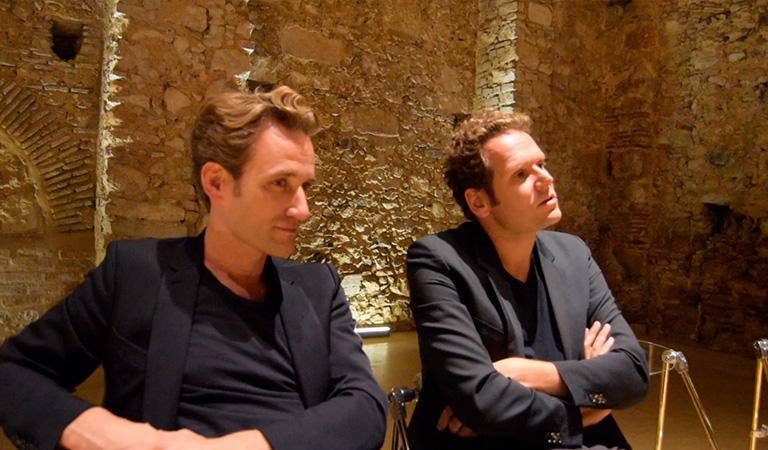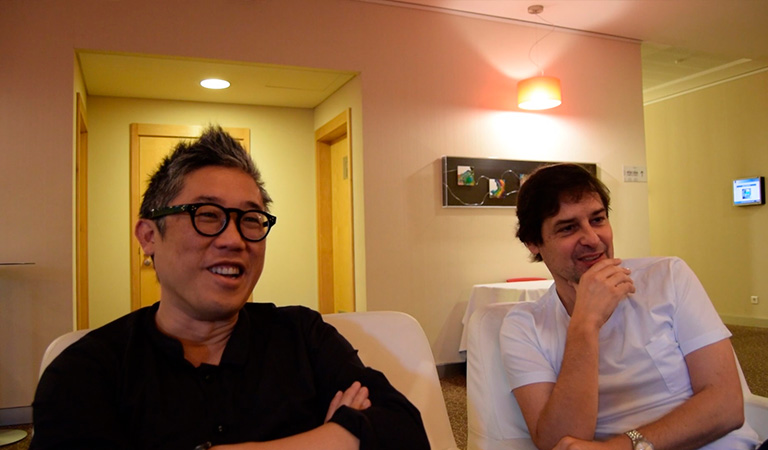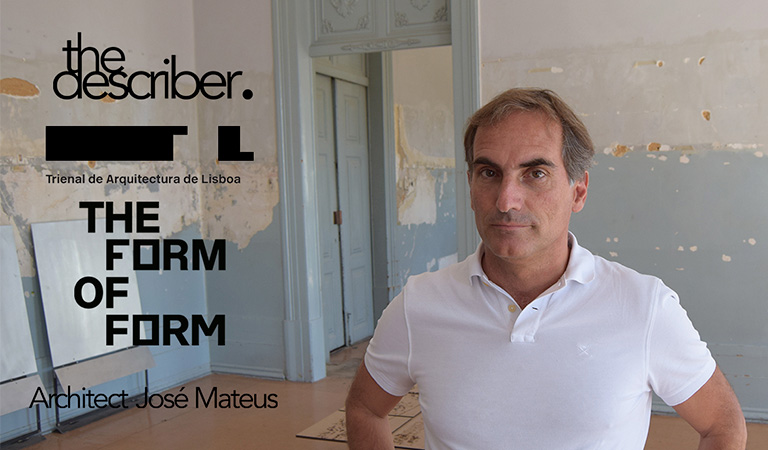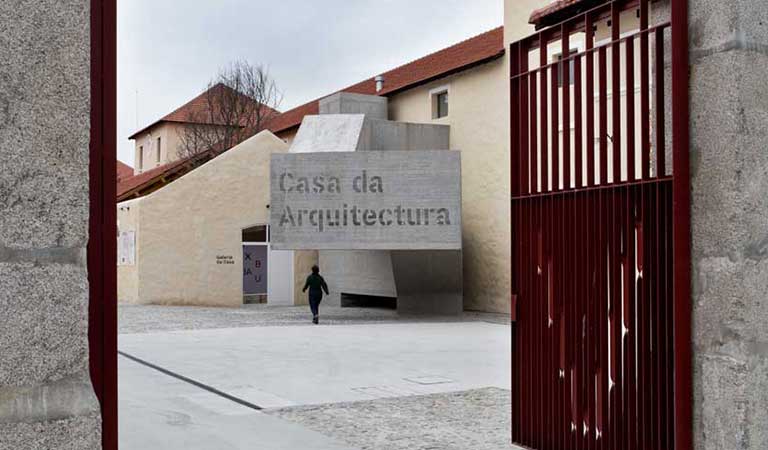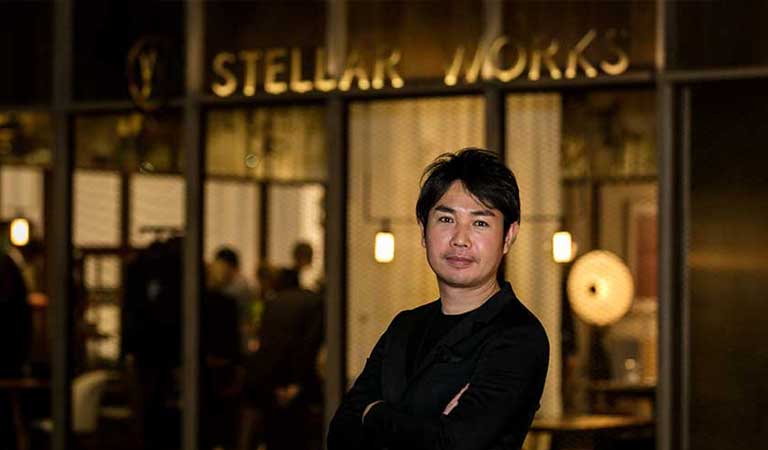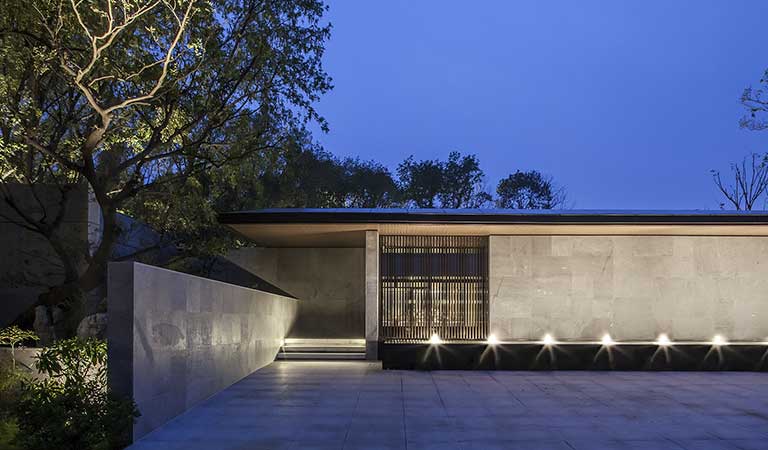This week on the Lisbon Architecture Triennale, we bring you the interview with Fig Projects founders, Francisca Insulza and Fabrizio Gallanti, curators of the exhibition The World in Our Eyes.
The World in Our Eyes observes how contemporary practitioners are engaged in the description of the city, and the different ways they observe and engage with the transformations of the urban condition stemming from the process of globalization.
Esta semana na cobertura da Trienal de Arquitectura de Lisboa, apresentamos a entrevista com os fundadores do escritório Fig Projects, Francisca Insulza e Fabrizio Gallanti, curadores da exposição O Mundo nos Nossos Olhos.
O Mundo nos Nossos Olhos observa como as práticas contemporâneas estão empenhadas na descrição da cidade, e as várias formas com que observam e se empenham nas transformações da condição urbana gerada nos processos de globalização.
Fig Projects
— FIG PROJECTS —
Francisca Insulza: The World in Our Eyes explores the way that architects look at the city. In that sense it’s the way that architects observe, represent and also learn from the city and use that learning in their designs and in their future work.
There are many projects in this exhibition, 36 projects with different points of view, different ways of looking, and they are organized in different groups according to this ways of looking.
Fabrizio Gallanti: And we tried to make a very comprehensive survey of examples from very different places, Asia, Europe, Latin America, North America, to see how the urban condition - that’s how the majority of humanity is living - is being inspiring for architects and is also a place of very intense political action. Because if you change the city, the territory, sometimes through design sometimes through policy, it’s possible somehow to have a positive impact on the lives of everyone.
So architects have a certain knowledge and expertise of how to represent the city, so we wanted to give a kind of broad understanding of this strategies.
We had 2 years of research from which we extracted 36 projects, so each project is one author or a group of authors, and then we organized this according to some themes. And the themes are seven:
The Urban Fantastic - Somehow the projection of a future for the city;
Urban Sprawl - What happens in the suburb, in a kind of very diffused city that now is more and more expanding from the traditional cities of the past;
Vast Geography - What architects observe and study when they think of regions and very large territories;
Structures and Super Structures - The possibility to understand the invisible, like economics, politics, how that has an impact on the way we live;
Taxonomists - People that do very precise catalogues of small fragments of the city, and if you put all of them together, you have the entire city;
The representation of the everyday life in the Spontaneous City- In a way citizens change the city and architects document how this transformations are happening outside of the control.
And one more, the Predominance of Geometry - Some research, where the geometry of one place, of one city is still very strong, a kind of skeleton on which then you can boost transformation.
Francisca Insulza: O Mundo Nos Nossos Olhos explora a forma que os arquitetos têm de olhar para a cidade. Nesse sentido, é a forma com que os arquitetos observam, representam e também aprendem com a cidade e usam essa aprendizagem nos seus projetos e no seu trabalho futuro.
Há muitos projetos nesta exposição, 36 projetos com diferentes pontos de vista, diferentes formas de olhar, e eles são organizados em diferentes grupos de acordo com estas formas de olhar.
Fabrizio Gallanti: E nós tentámos fazer um levantamento muito abrangente de exemplos de lugares muito diferentes, Ásia, Europa, América Latina, América do Norte, para ver como a condição urbana - é assim que a maioria da humanidade vive - é inspirador para arquitetos e é também alvo de uma ação política muito intensa. Porque se alterares a cidade, o território, por vezes, através do design, por vezes, através da política, é possível de alguma forma ter um impacto positivo na vida de todos.
Assim, e como os arquitetos têm um certo conhecimento e experiência de como representar a cidade, nós queríamos proporcionar um amplo entendimento destas estratégias.
Tivemos 2 anos de pesquisa a partir dos quais extraímos 36 projetos, de modo que cada projeto é um autor ou um grupo de autores, e organizámos os projetos de acordo com alguns temas. E os temas são sete:
Urbano Fantástico - De alguma forma, a projeção de um futuro para a cidade;
Por e Contra o Difuso - O que acontece no subúrbio, numa forma muito difusa de cidade que agora cada vez mais se expande das cidades tradicionais do passado;
Geografia Ampla - O que os arquitetos observam e estudam quando pensam em regiões e territórios muito vastos;
Estruturas e Superestruturas - A possibilidade de compreender o invisível, como a política, a economia, e como isso tem um impacto na forma como vivemos;
Indexação Taxonómica - Pessoas que fazem catálogos muito precisos de pequenos fragmentos da cidade, e ao colocá-los todos juntos, temos toda a cidade;
A representação da vida quotidiana na Cidade Espontânea - de certa forma os cidadãos mudam a cidade e os arquitetos documentam como esta transformação toma lugar e o que acontece fora do controlo institucional.
E mais uma, a Predominância da Geometria - Algumas pesquisas, onde a geometria de um lugar, de uma cidade, é ainda muito forte, uma espécie de esqueleto sobre o qual se impulsiona a transformação.
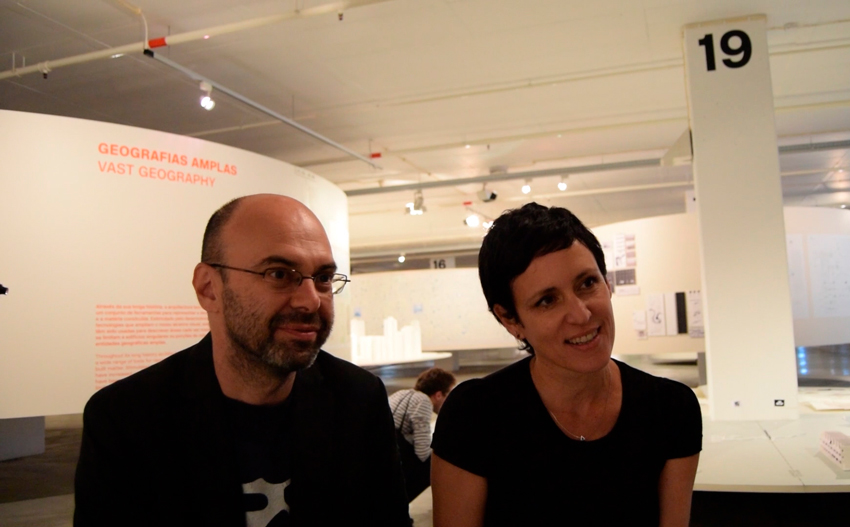
Fabrizio Gallanti and Francisca Insulza
Francisca Insulza: One thing that holds all of this works together is actually the way that architects make the invisible visible. So how the city and the urban matter is transforming and how we can represent those transformations, and understand the way that the city is transforming through representation.
Fabrizio Gallanti: And so these themes are organized following a design produced by a portuguese-swiss office Barão-Hutter, that established this kind of assemblage of circular islands to accommodate this topics, and the material that people will find is a combination of models, drawings, videos. We also wanted to show how the tools that are used by architects are very diverse, there’s not only one way of using architectural representation. You will see around, it’s textile, it’s drawing, it’s axonometric, it’s perspective, it’s interviews, it’s quite vast the palette of tools of representation.
Francisca Insulza: Uma coisa que mantém todos estes trabalhos como um conjunto é realmente a forma como os arquitetos tornam visível o invisível. De que forma a cidade e as questões urbanas se transformam e como podemos representar essas transformações, e entender de que maneira a cidade se transforma através da representação.
Fabrizio Gallanti: E estes temas são organizados seguindo um design produzido por um escritório português-suíço, Barão-Hutter, que estabeleceu este conjunto de ilhas circulares para acomodar este tópicos, e o material que as pessoas vão encontrar é uma combinação de modelos, desenhos, vídeos. Também queríamos mostrar como as ferramentas que são usadas pelos arquitetos são muito diversas, não há apenas uma maneira de utilizar a representação arquitetónica. Consegues ver em teu redor, é têxtil, é desenho, é axonometria, é perspectiva, são entrevistas, é bastante vasta a paleta de ferramentas de representação.
One can almost see this as a 101 introduction for politicians to understand that architects are needed and should be called upon to intervene…
Francisca Insulza: (laughs) Are needed yes…
Fabrizio Gallanti: (laughs) Yeah we think architects have the capacity of, I mean, they are not the only ones and the most interesting project is where architects are collaborating with other experts, but we have the capacity of interpretation, and the tradition of architectural representation can be used to reveal this aspects of the city, also to a public that sometimes is not specialized.
Quase podemos ver isto como uma introdução para que os políticos entendam que os arquitetos são necessários e devem ser chamados a intervir ...
Francisca Insulza: (risos) São necessários sim...
Fabrizio Gallanti: (risos) Sim, nós pensamos que os arquitetos têm a capacidade de, quero dizer, eles não são os únicos e o projeto mais interessante é aquele em que os arquitetos colaboram com outros especialistas, mas nós temos a capacidade de interpretação, e a tradição de representação arquitetónica pode ser utilizada para revelar estes aspectos da cidade, também para um público que, por vezes, não é especializado.
After 2 years you gave to this research, how do you see architecture and cities going from here? Are you more positive or negative about it?!
Francisca Insulza: Of course there are different points of view, some more positive, some more critical, but I think architects have the capacity to transform things into positive and so even the more critical aspects or the more critical issues that are brought up, are still put in a positive light.
In that sense what you mentioned about politicians is true, you know. We think that architects have that capacity and maybe they’ve been marginalized a little bit, but in the end through this representations, they make things appear to a larger audience and so can also envolve a larger audience in the decision making process.
Fabrizio Gallanti: A lot of the things in the show, they generate discussion, they generate debate, so a very beautiful drawing is not just a beautiful drawing, is something that people can start to have a conversation about.
In that sense we are quite optimistic, and we think that there might be a way to have architects again around the table producing this visions, around which you can somehow associate different cities.
There are two cases, one in New Jersey and one in Rio de Janeiro where exactly, what architects have been doing is providing that expertise to generate conversation between citizens, politicians, private sector, public sector. It’s really the kind of… the visibility of what was in the table that allowed people of very diverse race, religion, economy, to start to have a conversation together.
So I would say that we are…Positive after two years of work. (laughs)
Após 2 anos dedicados a esta pesquisa, como vêem a arquitetura e as cidades a partir daqui? São mais positivos ou negativos em relação a isso?!
Francisca Insulza: Claro que existem diferentes pontos de vista, alguns mais positivos, outros mais críticos, mas penso que os arquitetos têm a capacidade de transformar as coisas de forma positiva e por isso, até mesmo os aspectos mais críticos ou as questões mais críticas que surgem, são vistas à luz de uma abordagem positiva.
Nesse sentido o que tu mencionaste sobre os políticos é verdade. Nós pensamos que os arquitetos têm essa capacidade e talvez sejam um pouco marginalizados, mas no final, através destas representações, eles fazem chegar o seu trabalho a uma audiência maior e assim conseguem envolver essa audiência maior nos processos de decisão.
Fabrizio Gallanti: Muitas das coisas nesta exposição, elas geram discussão, elas geram debate, de modo que um belo desenho não é apenas um belo desenho, é algo sobre o qual as pessoas podem iniciar uma conversa.
Nesse sentido, somos bastante optimistas, e pensamos que poderia haver uma maneira de ter arquitetos novamente em redor da mesa a produzir estas perspectivas, em torno das quais podes de alguma forma associar diferentes cidades.
Há dois casos, um em New Jersey e um no Rio de Janeiro onde exatamente, o que os arquitetos têm vindo a fazer é proporcionar essa experiência para gerar conversa entre cidadãos, políticos, setor privado, setor público. É realmente o tipo de... a visibilidade do que estava em cima da mesa permitiu que pessoas de diferentes raças, religiões, economias, começassem a ter uma conversa em conjunto.
Como tal diria que nós somos... positivos após dois anos de trabalho. (risos)
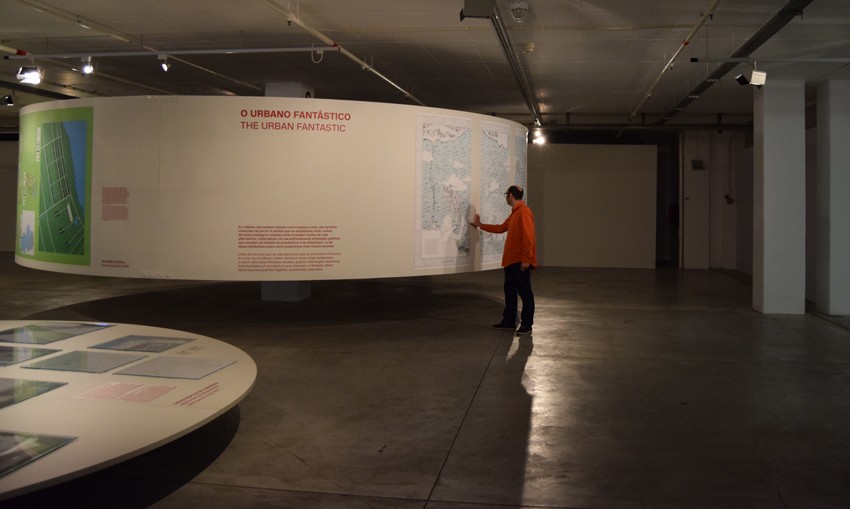
The World In Our Eyes
